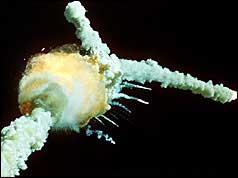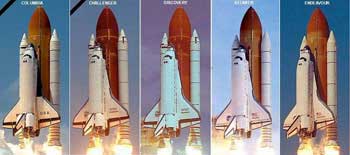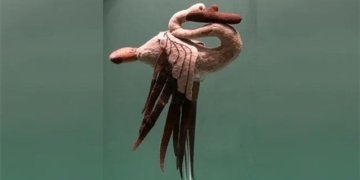 |
The Challenger exploded 73 seconds after its launch on January 28, 1986 (Photo: AP) |
On April 14, 1981, when the Columbia – the world’s first space shuttle – landed safely after completing 37 orbits around the Earth, a reporter asked Apollo 12 commander Pete Conrad: “Has the US caught up with the Soviet space program?” The astronaut who had walked on the moon joyfully replied: “Caught up? We’ve jumped over them!”
“Now everyone admits that (the space shuttle program) was not the right path” – Michael Griffin
Little did Conrad know that 25 years later, the US would have to temporarily suspend shuttle flights for safety reasons and spend millions of dollars “buying tickets” on Russia’s Soyuz spacecraft to send its astronauts and cargo to the International Space Station (ISS).
However, astronaut Conrad had nothing to be ashamed of, as even Wernher von Braun, the “father” of American rocketry, misjudged the capabilities of the shuttles. He was overly optimistic in predicting that American shuttles would land on the moon by the early 1980s.
Grand Ambitions
To be fair, the American space industry produced some of the most complex shuttles, employing technologies that many countries coveted but had yet to achieve. The former Soviet Union also had a similar shuttle program named Buran, but this program quickly failed.
Before Apollo landed on the moon (1969), in October 1968 NASA began researching the space shuttle. The shuttle program (officially known as the Space Transportation System – STS) was officially launched on January 5, 1972, with a statement from President Nixon declaring that NASA would develop a reusable shuttle system.
Choosing April 12, 1981 – exactly 20 years after the Soviet Union sent astronaut Yuri Gagarin into orbit – to launch the first shuttle demonstrated America’s determination to reclaim its number one position in space. For many years, five types of American shuttles (Columbia, Challenger, Discovery, Atlantis, Endeavour) proved their superiority by transporting 5-8 astronauts compared to Soyuz, which could carry a maximum of 3, launching satellites from low Earth orbit, constructing (mostly) the ISS, servicing the Hubble Space Telescope, and bringing back nearly 20 tons of equipment from space, among other achievements.
 |
Five types of shuttles (from left to right): Columbia, Challenger, Discovery, Atlantis, Endeavour |
Over the past 25 years, 114 shuttle flights were launched, but two missions ended in disaster, each claiming the lives of 7 astronauts. Since the last accident on February 1, 2003 (when Columbia disintegrated upon re-entry), shuttle flights were temporarily halted. Recently, in August of last year, Atlantis performed the 114th flight and encountered a similar issue to Columbia, but fortunately did not end in disaster, causing future flights, including 28 planned missions until 2010 – the deadline for the shuttle program set by President Bush to transition to a new space program – to be uncertain.
Harsh Realities
Even after a quarter of a century, what continues to trouble NASA’s top engineers is their inability to declare that they have moved past the testing phase due to harsher realities than they anticipated. One of the main reasons is that they cannot guarantee 100% safety for the astronauts’ lives. The safety of the 28 (planned) final flights of the STS program – according to an article on the website idlewords.com – is “a fifty-fifty chance.” Hundreds of millions of dollars have been spent since the Columbia disaster, but NASA engineers still have not resolved several technical issues that led to the tragic losses of the Challenger (1986) and Columbia (2003) crews.
The STS program planned to launch 30-40 flights each year, but in reality, the most flights executed in a single year (1985) was only 9. The STS program faced significant criticism not only for its technical aspects but also for financial reasons. According to NASA’s initial calculations, each flight was estimated to cost around $10-20 million. In reality, NASA admitted that the average cost per launch was no less than $55 million! By 2005, NASA had spent $145 billion on 114 launches. From now until 2010, an additional $174 million is projected to be spent, but this figure could increase.
Despite not meeting expectations, the STS program was maintained by NASA for one crucial reason: The ISS would never be completed if shuttle flights were halted. The ISS is a product of the Cold War. It was born to ensure a constant American presence in space, especially as Russia’s space program faced numerous challenges due to financial limitations compared to the Soviet era. The ISS was supposed to be completed by February 2004, but that deadline has now been pushed back to September 30, 2010. The US cannot abandon the ISS, and therefore cannot abandon the STS program.
Commercial Secrets
After 25 years of operating shuttle flights – the most advanced and largest means of transport, capable of carrying both astronauts and a significant amount of equipment unique to the US – between Earth and the ISS, only Russia can continue this mission as American shuttles do not guarantee safety for astronauts.
Last week, Michael Griffin, NASA’s Administrator, confirmed that NASA will continue to purchase services from Russia’s Soyuz to transport American astronauts and cargo to the ISS until the station is completed. The reason: After the Columbia disaster in early 2003, shuttle flights were temporarily suspended while safety improvements were awaited. However, Griffin did not specify how much NASA pays for each Soyuz flight. He only stated: “That is a commercial secret.” Previously, many billionaires had paid $20 million to fly on a Soyuz to visit the ISS.
Trọng Nghĩa compiled




















































